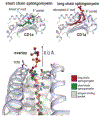CD1 displays its own negative regulators
- PMID: 37245411
- PMCID: PMC10527790
- DOI: 10.1016/j.coi.2023.102339
CD1 displays its own negative regulators
Abstract
After two decades of the study of lipid antigens that activate CD1-restricted T cells, new studies show how autoreactive αβ T-cell receptors (TCRs) can directly recognize the outer surface of CD1 proteins in ways that are lipid-agnostic. Most recently, this lipid agnosticism has turned to negativity, with the discovery of natural CD1 ligands that dominantly negatively block autoreactive αβ TCR binding to CD1a and CD1d. This review highlights the basic differences between positive and negative regulation of cellular systems. We outline strategies to discover lipid inhibitors of CD1-reactive T cells, whose roles in vivo are becoming clear, especially in CD1-mediated skin disease.
Copyright © 2023 Elsevier Ltd. All rights reserved.
Conflict of interest statement
Declaration of Competing Interest The authors declare possible perceived conflicts based on consultation for Pfizer, EnaraBio, and based on Brigham and Women's pending patents.
Figures


References
-
- Porcelli S, Brenner MB, Greenstein JL, Balk SP, Terhorst C, Bleicher PA: Recognition of cluster of differentiation 1 antigens by human CD4-CD8-cytolytic T lymphocytes. Nature 1989, 341:447–450. - PubMed
-
- Beckman EM, Porcelli SA, Morita CT, Behar SM, Furlong ST, Brenner MB: Recognition of a lipid antigen by CD1-restricted alpha-beta T cells. Nature 1994, 372:691–694. - PubMed
-
- Moody DB, Reinhold BB, Guy MR, Beckman EM, Frederique DE, Furlong ST, Ye S, Reinhold VN, Sieling PA, Modlin RL, et al.: Structural requirements for glycolipid antigen recognition by CD1b-restricted T cells. Science 1997, 278:283–286. - PubMed
-
- Kawano T, Cui J, Koezuka Y, Toura I, Kaneko Y, Motoki K, Ueno H, Nakagawa R, Sato H, Kondo E, et al.: CD1d-restricted and TCR-mediated activation of Valpha14 NKT cells by glycosylceramides. Science 1997, 278:1626–1629. - PubMed
-
- Borg NA, Wun KS, Kjer-Nielsen L, Wilce MC, Pellicci DG, Koh R, Besra GS, Bharadwaj M, Godfrey DI, McCluskey J, et al.: CD1d-lipid-antigen recognition by the semi-invariant NKT T-cell receptor. Nature 2007, 448:44–49. - PubMed
Publication types
MeSH terms
Substances
Grants and funding
LinkOut - more resources
Full Text Sources

